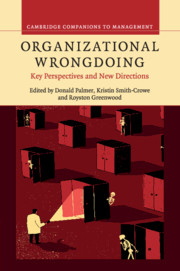Book contents
- Frontmatter
- Contents
- List of figures
- List of tables
- List of contributors
- Foreword
- 1 The imbalances and limitations of theory and research on organizational wrongdoing
- 2 On taking the theoretical substance of outcomes seriously: a meta-conversation
- 3 Wrong paths to right: defining morality with or without a clear red line
- 4 From market enablers to market participants: redefining organizational and political-legal arrangements and opportunities for financial wrongdoing,1930s–2000
- 5 Wrongdoing and market development: an examination of the distinct roles of trust and distrust
- 6 Bad apples, bad barrels and bad cellars: a “boundaries” perspective on professional misconduct
- 7 S/he blinded me with science: the sociology of scientific misconduct
- 8 Social networks and organizational wrongdoing in context
- 9 Falling stars: celebrity, infamy, and the fall from (and return to) grace
- 10 Compensation and employee misconduct: the inseparability of productive and counterproductive behavior in firms
- 11 Beware of organizational saints: how a moral self-concept may foster immoral behavior
- 12 “Is it me? Or is it me?” The role of coactivated multiple identities and identifications in promoting or discouraging workplace crimes
- 13 Consequences of organizational misconduct: too much and too little punishment
- 14 Who bears the brunt? A review and research agenda for the consequences of organizational wrongdoing for individuals
- 15 Organizational wrongdoing and media bias
- 16 Ethical learning: releasing the moral unicorn
- Index
- References
10 - Compensation and employee misconduct: the inseparability of productive and counterproductive behavior in firms
Published online by Cambridge University Press: 05 July 2016
- Frontmatter
- Contents
- List of figures
- List of tables
- List of contributors
- Foreword
- 1 The imbalances and limitations of theory and research on organizational wrongdoing
- 2 On taking the theoretical substance of outcomes seriously: a meta-conversation
- 3 Wrong paths to right: defining morality with or without a clear red line
- 4 From market enablers to market participants: redefining organizational and political-legal arrangements and opportunities for financial wrongdoing,1930s–2000
- 5 Wrongdoing and market development: an examination of the distinct roles of trust and distrust
- 6 Bad apples, bad barrels and bad cellars: a “boundaries” perspective on professional misconduct
- 7 S/he blinded me with science: the sociology of scientific misconduct
- 8 Social networks and organizational wrongdoing in context
- 9 Falling stars: celebrity, infamy, and the fall from (and return to) grace
- 10 Compensation and employee misconduct: the inseparability of productive and counterproductive behavior in firms
- 11 Beware of organizational saints: how a moral self-concept may foster immoral behavior
- 12 “Is it me? Or is it me?” The role of coactivated multiple identities and identifications in promoting or discouraging workplace crimes
- 13 Consequences of organizational misconduct: too much and too little punishment
- 14 Who bears the brunt? A review and research agenda for the consequences of organizational wrongdoing for individuals
- 15 Organizational wrongdoing and media bias
- 16 Ethical learning: releasing the moral unicorn
- Index
- References
Summary
Incentive systems play a fundamental role in organizations. Financial compensation represents the largest single cost for the average company (Gerhart, Rynes, and Fulmer 2009), and compensation is intimately tied to firm strategy and performance (Larkin, Pierce, and Gino 2012; Nickerson and Zenger 2008). Well-designed compensation systems allow firms to direct employee effort toward productive activities that improve firm performance and survival. Just as importantly, compensation systems can play a key role in attracting and retaining the right types of employees based on heterogeneous ability, motivation levels, and social connections. Although financial and other extrinsic incentives built into compensation systems are powerful tools for improving productivity, they also carry substantial risks. Compensation systems can generate perverse economic incentives as well as psychological and social responses that motivate a wide class of counterproductive behaviors ranging from lack of cooperation to explicitly illegal misconduct.
This chapter focuses on illuminating the holistic implications of multiple classes of compensation systems for employee behavior. We focus on non-executive employees for several reasons. First, an extensive literature in finance, strategy, and management covers executive compensation. Second, the key issues in executive compensation, such as motivating the appropriate level of risk and minimizing high-level corporate fraud, are quite different from the tradeoffs managers face when motivating non-executive employees (Larkin et al. 2012). Finally, the pay of top executives typically accounts for only a few percentage points of total firm compensation costs (Whittlesey 2006).
Incentive systems are fundamentally about motivating employee behavior (Hall 2000). In this chapter, we focus on both productive behaviors and counterproductive misconduct that are motivated by compensation systems. Productive behaviors are defined as those that contribute to the performance and ultimate success of the firm (as measured by profitability for most for-profit firms, but that can include other metrics). Misconduct includes several types of behaviors that are counterproductive to the firm: actions that are explicitly illegal, actions that violate formal organizational rules, actions that may not violate rules but are against the spirit of the rules, and actions that are counter-normative. Fundamentally, employees engage in misconduct because they believe it will increase their utility or happiness; misconduct can generate higher extrinsic rewards, such as pay, promotion, or status, and can also increase psychological well-being.
- Type
- Chapter
- Information
- Organizational WrongdoingKey Perspectives and New Directions, pp. 270 - 304Publisher: Cambridge University PressPrint publication year: 2016
References
- 15
- Cited by



